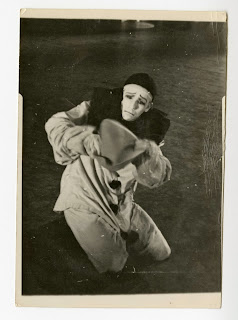1.
Who are you and what is your position?
Jeri Smalley -
Ballets Russes Archivist
2.
Please give us a little bit of background
I received my undergraduate and graduate degrees in dance from the
University of Wisconsin – Madison and embarked on a career teaching dance,
choreographing, and doing administrative work at colleges, companies, and
studios in Wisconsin and Illinois. After a couple of moves and career changes,
I received my MLS from the University of Oklahoma (OU) Library School in 2004
where I had taken archival courses with Kathleen Haynes of the faculty and Bill
Welge of the Oklahoma History Center Research Division. I then volunteered at
the History Center where I helped process a large collection donated by former
Sac and Fox tribal official Mary McCormick.
3.
When did you come to the Ballets Russes Archive?
I saw the Ballets Russes film when the filmmakers Dayna Goldfine and Dan
Geller presented it for a University of Oklahoma dream course. I had heard that
the School of Dance had the archive and I spoke with the Director, Mary
Margaret Holt, about volunteering to help organize and build the infrastructure
of the archive.
4.
Why did you become a part of the Ballets Russes
Archive?
I have a lifelong love of dance and was actively involved in the field
for many years. Part of my study of dance history included reading about the
Ballets Russes companies, their founders, dancers, and artists. Combining my
dance and archival activities by working with the archive gives me the best of
both worlds.
5.
What aspects of the Ballets Russes Archive have
you worked on?
I came into the archive at a very early stage and have enjoyed helping
shape it into a professional archive. I have helped create the infrastructure,
drafting and refining the deed of gift that gives us legal right to the objects
donors entrust to the archive, creating record tracking systems for donations,
adopting systems for describing and arranging collections, seeking out and
working with volunteers and organizations with whom we partner in order to make
our holdings known and available to the public.
I have also enjoyed working with some of the graduate assistants from the
School of Dance and the School of Library Studies at OU who have been involved
with the archive in recent years and have worked diligently to further our
goals of making our holdings available to as wide a public as possible.
6.
What are the biggest challenges you faced in
working with the Archive?
As a very part time person, working with other part time personnel, there
is always the knowledge that what “needs to be done” won’t happen at the speed at
which you would like to see things happen. Also, as personnel graduate and are
replaced, making sure that we record what we do for future personnel is ongoing
and important.
7.
What are the biggest successes you have achieved
with the Archive?
Helping shape the Archive (as I discussed earlier) from boxes of papers,
photos, DVDs, and other items, into a useful, coherent group of archival
collections. Taking a collection of not-very-organized and documented donations
and helping shape them into processed collections with finding aids for many
now available online. When I first volunteered with the Archive, a number of
former dancers had donated manuscripts, photographs, ephemera, and digital
files to the OU School of Dance. These items had been received and put into
archival boxes by Peggy Chaffin, administrative assistant and donor liaison but
had not been further processed. Helping
create the professional archival infrastructure and working with others to move
the collections of objects into a cohesive, meaningful research resource has
been very fulfilling.
8.
What are your favorite items or collections in
the Archive?
One of the first collections I
inspected and worked with was the Bernice Rehner Collection. This has remained
one of my favorites because it is a time capsule in the life of a corps member
of one of the Ballets Russes companies. It contains unique items that make the
day-to-day lives of company members come vividly to life, including rehearsal
schedules, snapshots, napkin art by company member George Verdak,
correspondence pertaining to the American Guild of Musical Artists (Bernice was
the AGMA representative for the company for a time), and correspondence with
her family while she was in the company.
Although other collections
including the Branitzka-Hoyer and Bechenova Collections are special for
documenting transitional years from the Diaghilev era to the de Basil era,
Bernice’s collection probably remains my favorite.
9.
What are your hopes for the future of the
Archive?
I
look forward to seeing the number of unique collections grow and become more
accessible to researchers. With a web presence via our Facebook page, blog, and
website we have begun to get some genealogically focused inquiries from people
with family members and friends who had ties with one of the Ballets Russes
companies and would like to know more about that time in their ancestor’s life.
I look forward to further use of the
collection by students and researchers of dance, music, and the theatre arts
both online and in house.



























